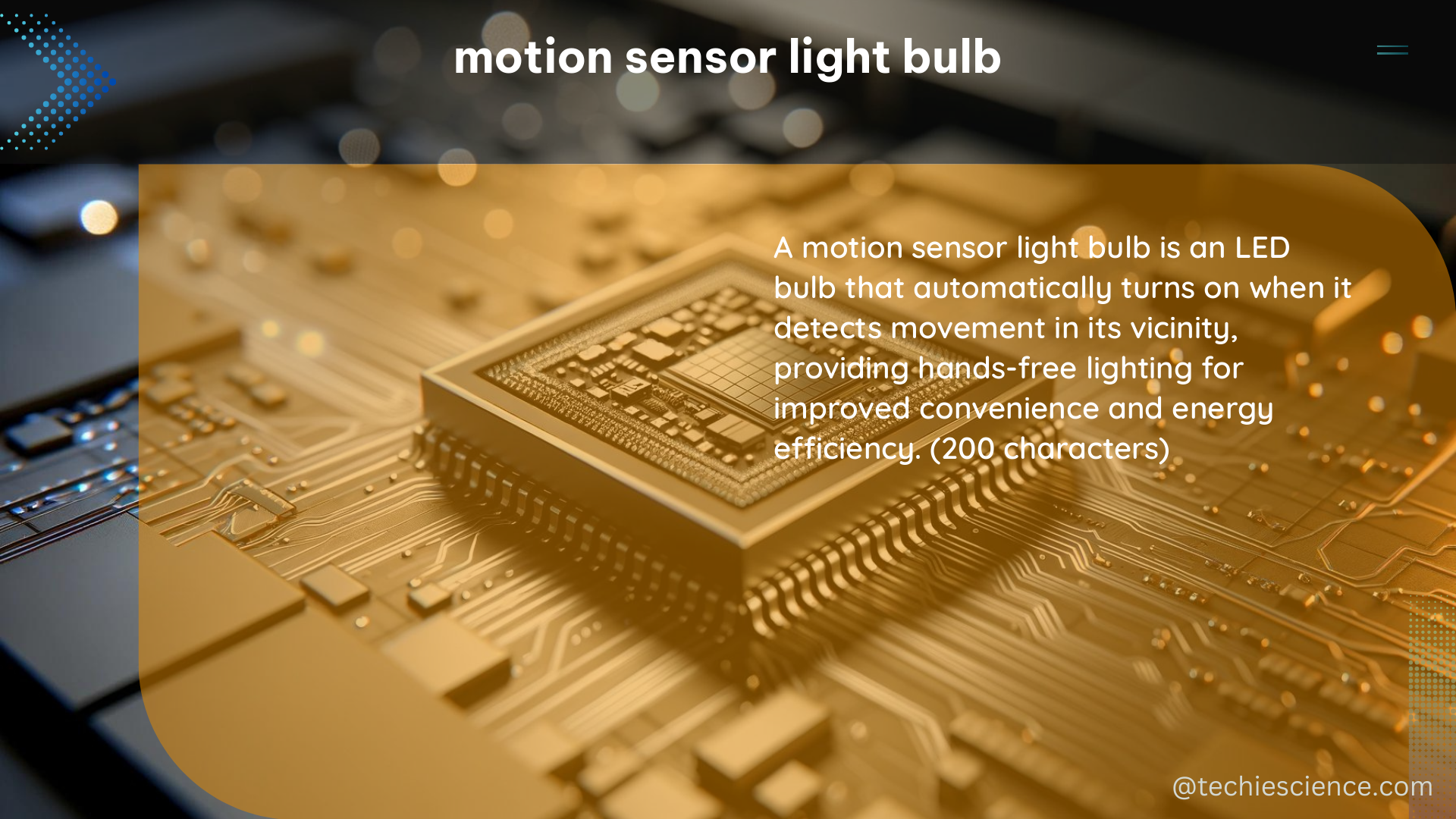Motion sensor light bulbs are a versatile and energy-efficient solution for both indoor and outdoor lighting applications. These bulbs are designed to automatically turn on and off in response to movement, providing a convenient and secure way to illuminate your living spaces. Whether you’re looking to enhance your home’s security, improve energy efficiency, or simply add a touch of convenience to your daily routine, understanding the technical specifications and installation process of motion sensor light bulbs is crucial.
Technical Specifications of Motion Sensor Light Bulbs
When selecting a motion sensor light bulb, it’s important to consider the following technical specifications:
Range
The range of a motion sensor light bulb refers to the maximum distance at which the sensor can detect movement. This is typically measured in feet or meters and can vary significantly between different models. For example, the Philips Hue Motion Sensor has a range of up to 39 feet (12 meters), while the Sengled Motion Sensor Bulb has a range of up to 26 feet (8 meters).
Field of View
The field of view (FOV) of a motion sensor light bulb refers to the angle at which the sensor can detect movement. This is typically measured in degrees and can range from a narrow 90-degree FOV to a wide 360-degree FOV. A wider FOV can be beneficial for covering larger areas, but may also be more susceptible to false triggers from peripheral movement.
Sensitivity
The sensitivity of a motion sensor light bulb refers to how easily the sensor can be triggered by movement. This is often adjustable, allowing you to fine-tune the sensor’s responsiveness to suit your specific needs. For example, the Philips Hue Motion Sensor has three sensitivity settings: low, medium, and high.
Brightness
The brightness of a motion sensor light bulb is typically measured in lumens, with higher lumen values indicating a brighter output. This can be an important consideration, especially for outdoor lighting applications where you may want a more powerful illumination.
Energy Efficiency
Motion sensor light bulbs are designed to be energy-efficient, with many models using LED technology to reduce power consumption. The energy efficiency of a motion sensor light bulb is often measured in watts, with lower wattage values indicating a more efficient bulb.
Lifespan
The expected lifespan of a motion sensor light bulb is an important consideration, as it can impact the long-term cost and maintenance of your lighting system. Many motion sensor light bulbs are rated for thousands of hours of use, with some models boasting lifespans of up to 25,000 hours.
Installation and Compatibility Considerations

In addition to the technical specifications, it’s also important to consider the ease of installation and compatibility of a motion sensor light bulb with your existing lighting fixtures and home automation systems.
Installation
Some motion sensor light bulbs may require special wiring or installation hardware, while others can be as simple to install as a regular light bulb. It’s important to carefully follow the manufacturer’s instructions to ensure proper installation and avoid any potential safety hazards.
Compatibility
Motion sensor light bulbs can be compatible with a variety of home automation systems, such as smart home hubs and voice assistants. This can allow you to integrate your lighting system with other smart home devices, enabling advanced features like remote control, scheduling, and integration with other smart home routines.
Alternatives for Daytime Motion Sensor Activation
As mentioned in the original answer, finding motion sensor light bulbs that turn on during the day can be a challenge, as many models include a “Dusk to Dawn” sensor that only activates the bulb during low-light conditions. However, there are a few alternatives to consider:
-
Non-Smart Bulbs with Built-in Motion Sensors: Some non-smart motion sensor light bulbs can be triggered by movement regardless of the time of day, making them a viable option for daytime activation.
-
Smart Bulbs with Separate Motion Sensors: By using a smart bulb in conjunction with a separate motion sensor, you can program the system to turn the bulb on and off in response to movement, regardless of ambient light levels.
-
Motion Sensor Adapters: Another option is to use a motion sensor adapter that can be installed between a standard light bulb and the fixture. These adapters can provide motion-activated control without the need for a specialized motion sensor light bulb.
Conclusion
Motion sensor light bulbs offer a convenient and energy-efficient solution for both indoor and outdoor lighting applications. By understanding the technical specifications, installation requirements, and compatibility considerations, you can select the right motion sensor light bulb for your needs and ensure a seamless integration with your home’s lighting system. Whether you’re looking to enhance security, improve energy efficiency, or simply add a touch of convenience to your daily routine, motion sensor light bulbs are a versatile and practical choice.
Reference Links:
- How Light Sensors Work
- The Influence of Lighting on Human Circadian Rhythms and Sleep
- Question: Is there a smart light blub with a motion sensor that turns on during the day?
- How to Fool a Motion Sensing Lighting Control
- How Can I Write a Resume When My Jobs Don’t Have Measurable Results?

The lambdageeks.com Core SME Team is a group of experienced subject matter experts from diverse scientific and technical fields including Physics, Chemistry, Technology,Electronics & Electrical Engineering, Automotive, Mechanical Engineering. Our team collaborates to create high-quality, well-researched articles on a wide range of science and technology topics for the lambdageeks.com website.
All Our Senior SME are having more than 7 Years of experience in the respective fields . They are either Working Industry Professionals or assocaited With different Universities. Refer Our Authors Page to get to know About our Core SMEs.